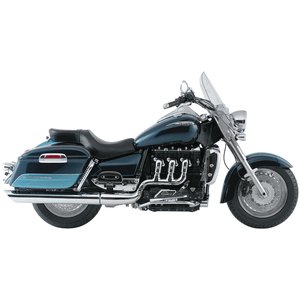Triumph Rocket 3 Touring (2008-2017): A Decade of Dominance in the Touring Cruiser Segment
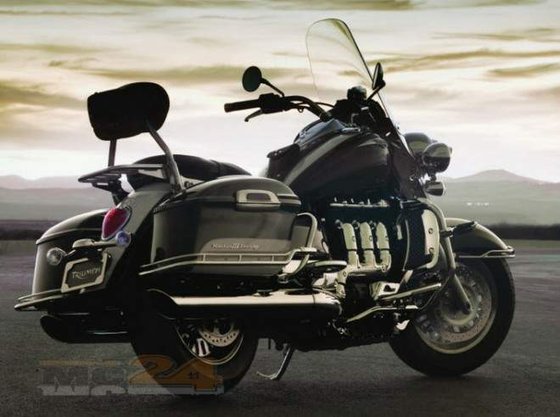
Introduction
The Triumph Rocket 3 Touring isn’t just a motorcycle—it’s a statement. From 2008 to 2017, this British behemoth redefined what a touring cruiser could be, blending the raw power of the world’s largest production motorcycle engine with long-distance practicality. With its 2.3L inline-three engine, relaxed ergonomics, and factory-equipped touring accessories, the Rocket 3 Touring carved out a niche that no competitor could match. This review dives into the essence of owning and riding Triumph’s heavyweight champion, exploring why it remains a cult favorite among riders who crave torque, presence, and versatility.
Design: Where Muscle Meets Purpose
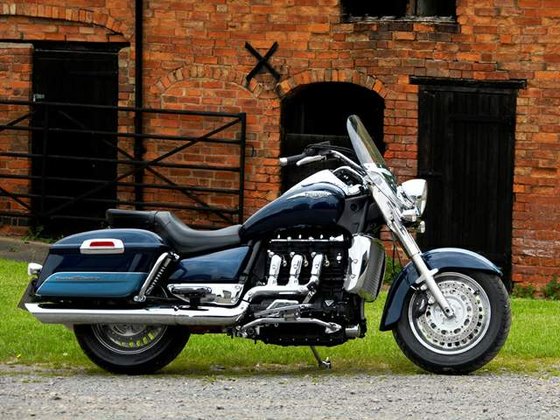
Aesthetic Authority
The Rocket 3 Touring’s design is unapologetically bold. Its 2500mm (98.4") length and 395kg (870 lbs) wet weight command attention, but Triumph’s clever engineering ensures it never feels unwieldy. The twin-spine steel frame houses the longitudinal three-cylinder engine low in the chassis, creating a center of gravity that defies its size. The 2010-2017 models added sharper details like color-matched hard panniers, a quick-release windscreen, and chrome accents, striking a balance between brawn and sophistication.
Ergonomics Built for the Long Haul
With a seat height of 730mm (28.7") and pullback handlebars, the riding position is a masterclass in cruiser comfort. Floorboards (instead of pegs) let riders stretch their legs, while the 18-inch-wide dual-density seat—with a gel layer for the pillion—absorbs road imperfections. The 2013 update introduced chrome engine dresser bars and a sissy bar, enhancing both style and passenger security.
Practical Touches
- Lockable panniers: 36L capacity (total), water-resistant and quick-detach.
- Adjustable suspension: Kayaba shocks with 5-position preload (105mm rear travel) adapt to loads.
- 16-inch wheels: A 180/70 rear tire improves agility over the standard Rocket III’s 240mm brute.
Engine: The Heart of a Titan
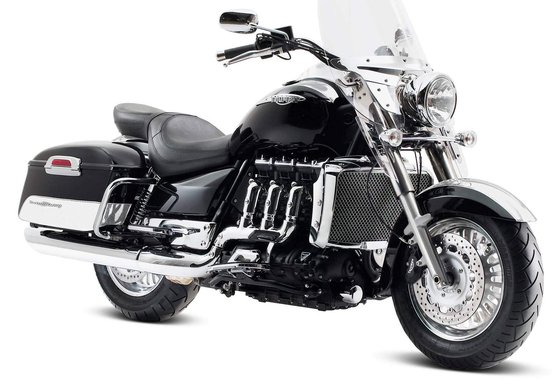
Torque: The Rocket’s Rocket Fuel
At the core of this machine lies a 2294cc inline-three, a configuration unique to Triumph in the cruiser world. While peak power ranges from 106–148 HP across model years, the real story is torque: 203–221 Nm (150–163 lb-ft) available as low as 2000 RPM. This isn’t just numbers—it’s a sensation. Roll on the throttle at highway speeds, and the Rocket surges forward without downshifting, its shaft drive translating power seamlessly.
Tuned for Touring
Unlike the hyper-aggressive Rocket III Roadster, the Touring variant prioritizes low-end grunt. Triumph’s engineers detuned the engine for smoother delivery, ideal for two-up riding or hauling luggage. Fuel efficiency sits around 8.1L/100km (29 MPG), granting a 300km (186-mile) range from its 22–24L tank.
Signature Sound & Soul
The stainless-steel 3-into-1-into-2 exhaust delivers a bass-heavy growl, muted enough for long rides but throaty under acceleration. Post-2011 models added catalytic converters, but the character remains intact—a blend of industrial might and refined cruising.
Ride Experience: Taming the Beast
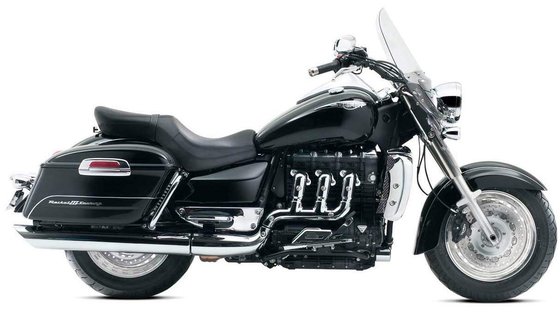
Urban Maneuverability
Don’t let the specs intimidate you. The Rocket’s low seat and narrow handlebars (compared to its width) make parking-lot maneuvers surprisingly manageable. The hydraulic clutch requires minimal effort, and the heel-toe shifter (a love-it-or-hate-it feature) becomes second nature over time.
Highway Dominance
At 110km/h (68 MPH), the Rocket settles into its sweet spot. The windscreen deflects buffeting, while the floorboards and seat isolate vibrations. With 150 lb-ft torque on tap, overtaking is a lazy twist of the wrist—no gear changes needed.
Twisties? Yes, Seriously
The Touring’s 32° rake and 152–184mm (6–7.2") trail lend unexpected agility. Mid-corner bumps are soaked up by the 43mm Kayaba forks, and the Metzeler tires provide ample grip. Ground clearance is generous for a cruiser, though the floorboards will scrape if pushed hard.
Customization Potential
Owners often personalize their Rockets with aftermarket exhausts (boosting horsepower to 125+), solo seats, or lower handlebars. These mods transform the Touring into a boulevard cruiser, proving its versatility.
Competition: How the Rocket Stacks Up
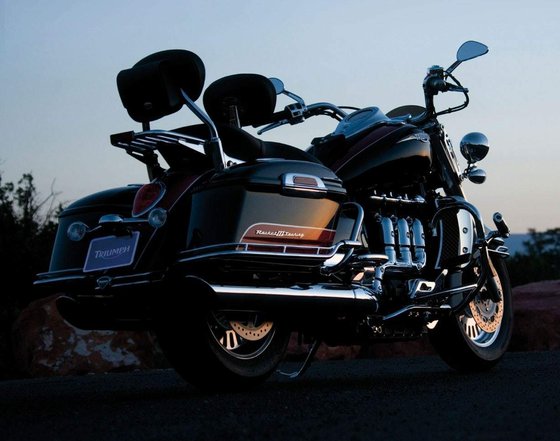
1. Harley-Davidson Heritage Softail
- Pros: Brand legacy, aftermarket support, lower seat height.
- Cons: 1868cc V-twin makes just 135 Nm (100 lb-ft) torque; chain drive requires more maintenance.
- Verdict: The Heritage excels in nostalgia but can’t match the Rocket’s torque or tech (ABS was standard on the Triumph post-2011).
2. Victory Cross Roads
- Pros: Lighter (357kg/787 lbs), agile, 1731cc V-twin with 146 Nm (108 lb-ft) torque.
- Cons: Discontinued in 2017; smaller engine lacks the Rocket’s visceral pull.
- Verdict: A worthy challenger in handling, but the Triumph’s engine is a different league.
3. Honda Gold Wing
- Pros: Legendary comfort, six-cylinder smoothness, superior wind protection.
- Cons: Higher price, complex maintenance, less “soul.”
- Verdict: The Gold Wing is a touring benchmark, but the Rocket appeals to riders wanting raw character over polish.
Maintenance: Keeping the Legend Alive
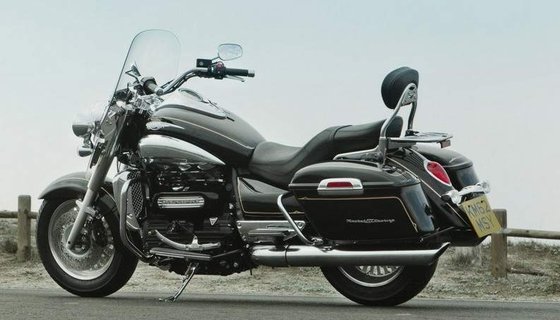
Key Considerations
- Shaft Drive: Unlike chain-driven rivals, the Rocket’s shaft requires minimal upkeep—just annual oil changes (170ml SAE 75W-90).
- Valve Adjustments: Every 16,000km (10,000 miles), check valve clearances (0.10–0.15mm cold).
- Oil & Fluids: Use synthetic 15W/50 oil (5.9L capacity). Coolant changes every 48,000km (30,000 miles).
- Brakes: Nissin 4-piston front calipers wear pads faster than expected; upgrade to sintered pads for longevity.
- Tires: The 150/80-R16 front and 180/70-R16 rear last ~12,000km (7,500 miles). Check pressures monthly (2.5 bar/36 psi front, 2.8 bar/41 psi rear).
MOTOPARTS.store Recommendations
- Performance: High-flow air filters and remapped ECUs unlock hidden power.
- Comfort: Gel seat inserts or heated grips enhance long rides.
- Aesthetics: Chrome accessory kits or LED auxiliary lights modernize the look.
Conclusion: The Unrivaled Touring Contender
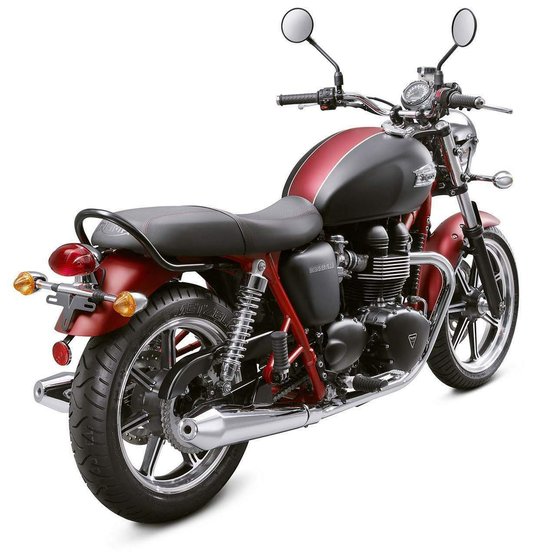
The Triumph Rocket 3 Touring is a study in contradictions—a colossus that handles like a middleweight, a retro-styled cruiser with modern tech, and a gentleman’s express that can still shred rear tires. While its production ended in 2017, its legacy lives on in the used market, where well-maintained examples are prized. For riders who value torque over top speed and personality over conformity, the Rocket 3 Touring remains in a class of one.
Whether you’re planning a cross-country odyssey or turning heads on Main Street, this Triumph proves that bigger really can be better. And when it’s time to service or upgrade, MOTOPARTS.store has the expertise and parts to keep your Rocket soaring.
Images: , ,





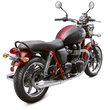
Specifications sheet
| Engine | |
|---|---|
| Stroke: | Four-stroke |
| Max power: | 108 kW | 145.0 hp |
| Max torque: | 203 Nm |
| Fuel system: | Multipoint sequential electronic fuel injection with twin butterflies |
| Max power @: | 5750 rpm |
| Displacement: | 2294 ccm |
| Max torque @: | 2500 rpm |
| Bore x stroke: | 101.6 x 94.3 mm (4.0 x 3.7 in) |
| Configuration: | Inline |
| Cooling system: | Liquid |
| Compression ratio: | 8.7:1 |
| Number of cylinders: | 3 |
| Dimensions | |
|---|---|
| Wheelbase: | 1705 mm (67.1 in) |
| Dry weight: | 358 |
| Wet weight: | 395 |
| Seat height: | 730 mm (28.7 in) |
| Overall width: | 995 mm (39.1 in) |
| Overall height: | 1182 mm (46.5 in) |
| Overall length: | 2603 mm (102.4 in) |
| Fuel tank capacity: | 22.3 L (5.9 US gal) |
| Drivetrain | |
|---|---|
| Final drive: | shaft |
| Gear ratios: | 1st: 41/14, 2nd: 37/19, 3rd: 33/23, 4th: 29/25, 5th: 27/28 |
| Transmission: | 5-speed |
| Maintainance | |
|---|---|
| Engine oil: | 10W40 |
| Break fluid: | DOT 4 |
| Spark plugs: | NGK DPR7EA-9 or NGK DPR7EIX-9 |
| Spark plug gap: | 0.9 |
| Final drive oil: | 170 ml SAE 75W-90 |
| Coolant capacity: | 3.2 |
| Forks oil capacity: | 1.3 |
| Engine oil capacity: | 5.9 |
| Engine oil change interval: | Every 5000 km or 2 years |
| Valve clearance (intake, cold): | 0.10–0.15 mm |
| Valve clearance check interval: | 24,000 km |
| Valve clearance (exhaust, cold): | 0.10–0.15 mm |
| Recommended tire pressure (rear): | 2.8 bar (41 psi) |
| Recommended tire pressure (front): | 2.5 bar (36 psi) |
| Additional Features | |
|---|---|
| ABS: | Standard (2011+) |
| Instruments: | Analog speedometer with LCD trip computer |
| Color options: | ['Phantom Black', 'Cranberry Red/Phantom Black', 'Jet Black/White'] |
| Factory warranty: | 2 years unlimited mileage |
| Carrying capacity: | 36L lockable panniers |
| Chassis and Suspension | |
|---|---|
| Rake: | 32° |
| Frame: | Tubular steel twin-spine |
| Trail: | 184 mm (7.2 in) |
| Rear tire: | 180/70-16 |
| Front tire: | 150/80-16 |
| Rear brakes: | Single 316 mm disc, Brembo 2-piston caliper, ABS |
| Front brakes: | 2 x 320 mm discs, Nissin 4-piston calipers, ABS |
| Rear suspension: | Kayaba chromed spring twin shocks, 105 mm travel, 5-position preload adjustment |
| Front suspension: | 43mm Kayaba upside-down forks, 120 mm travel |



